Class 10 - Mathematics
Areas Related To Circles - Exercise 12.3

Top Block 1
Exercise 12.3
Question : 1:Find the area of the shaded region in Fig. 12.19, if PQ = 24 cm, PR = 7 cm and O is the centre of the circle.

Answer :
Since O is the centre of the circle,
So, QOR is a diameter.
⇒ ∠RPQ = 90° [Angle in a semi-circle]
Now, in right angle triangle RPQ,
RQ2 = PQ2 + PR2
⇒ RQ2 = 242 + 72
⇒ RQ2 = 756 + 49
⇒ RQ2 = 625
⇒ RQ = √625
⇒ RQ = 25
Area of ΔRPQ = (1/2) * RQ * RP
= (1/2) * 24 * 7
= 12 * 7
= 84 cm2
Now, area of semi-circle = πr2/2
= (1/2) * (22/7) * (25/2) * (25/2)
= (11 * 625)/(7 * 4)
= 6875/28
= 245.54 cm2
So, area of the shaded portion = 245.54 – 84 = 161.54 cm2
Question : 2:Find the area of the shaded region in Fig. 12.20, if radii of the two concentric circles with centre O are 7 cm and 14 cm respectively and ∠ AOC = 40°.

Mddle block 1
Answer :

Here, θ = 40°
So, area of the sector BOD = (40°/360°) * (22/7) * 7 * 7
= (1/9) * 22 * 7
= 154/9 cm2
Now, area of the shaded region = Area of sector AOC – Area of sector BOD
= (40°/360°) * (22/7) * 14 * 14 – 154/9
= (1/9) * 22 * 14 * 2 – 154/9
= 616/9 – 154/9
= (616 – 154)/9
= 462/9
= 154/3 cm2
Question : 3:Find the area of the shaded region in Fig. 12.21, if ABCD is a square of side 14 cm and APD and BPC are semicircles.
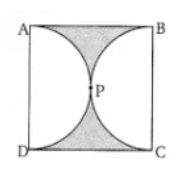
Answer :

Area of the square ABCD = 14 * 14 = 196 cm2
Now, diameter of the circle = (Side of the square) = 14 cm
Radius of each of the circle = 14/2 = 7 cm
Area of the semi-circle APB = πr2/2
= (1/2) * (22/7) * 7 * 7
= 11 * 7
= 77 cm2
Area of the semi-circle BPC = πr2/2
= (1/2) * (22/7) * 7 * 7
= 11 * 7
= 77 cm2
Now, area the shaded region = Area of the square] – [Area of semi-circle APD + Area of semi-circle BPC]
= 196 – [77 + 77]
= 196 – 154
= 42 cm2
Question : 4:Find the area of the shaded region in Fig. 12.22, where a circular arc of radius 6 cm has been drawn with vertex O of an
equilateral triangle OAB of side 12 cm as centre.
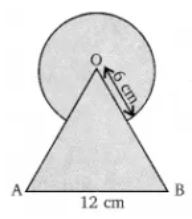
Answer :

Area of sector OCDE = (60°/360°) * πr2
= (1/6) * (22/7) * 6 * 6
= 132/7 cm2
Area of equilateral triangle OAB = (√3/4) * (12)2
= (√3/4) * 12 * 12
= √3 * 3 * 12
= 36√3 cm2
Area of circle = πr2
= (22/7) * 6 * 6
= 792/7 cm2
Now, area of shaded region = area of circle + area of ΔOAB – area of sector OCDE
= 792/7 + 36√3 – 132/7
= (792 – 132)/7 + 36√3
= (36√3 + 660/7) cm2
Question : 5:From each corner of a square of side 4 cm a quadrant of a circle of radius 1 cm is cut and also a circle of diameter 2 cm is cut as shown in Fig. 12.23.
Find the area of the remaining portion of the square.

Answer :

Area of each quadrant = (90°/360°) * πr2
= (1/4) * (22/7) * 1 * 1
= (1/1) * (11/7)
= 11/14 cm2
Area of square = (side)2 = 42 = 16 cm2
Area of circle = πr2 = π * 1 * 1 = π = 22/7 cm2
Now, area of shaded region = area of square – area of circle – area of 4 quadrant
= 16 – 22/7 – 4 * 11/14
= 16 – 22/7 – 22/7
= 16 – 44/7
= (112 – 44)/7
= 68/7 cm2
Question : 6:In a circular table cover of radius 32 cm, a design is formed leaving an equilateral
triangle ABC in the middle as shown in Fig. 12.24. Find the area of the design (shaded region).
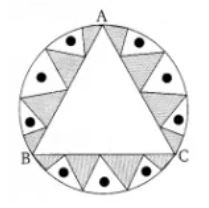
Answer :

Centroid O divides median AD into 2 : 1, therefore AO : OD = 2 : 1
⇒ AO/OD = 2/1
⇒ 32/OD = 2/1
⇒ OD = 32/2
⇒ OD = 16 cm
Therefore, AD = 32 + 16 = 48 cm
In ΔABD,
AB2 = AD2 + BD2
⇒ AB2 = 482 + (AB/2)2
⇒ AB2 = 482 + AB2/4
⇒ AB2 – AB2/4 = 482
⇒ 3AB2/4 = 482
Take square root on both sides, we get
⇒ √3AB/2 = 48
⇒ AB = (48 * 2)/√3
⇒ AB = (16 * √3 * √3 * 2)/√3
⇒ AB = 32√3
Area of equilateral triangle ABC = (√3/4) * (32√3)2
= 768√3 cm2
Area of circle = πr2 = (22/7) * 32 * 32 = 22528/7 cm2
Now, area of design = area of circle – area of equilateral triangle ABC
= (22528/7 – 768√3) cm2
Question : 7:In Fig. 12.25, ABCD is a square of side 14 cm. With centres A, B, C and D, four circles are drawn such
that each circle touch externally two of the remaining three circles. Find the area of the shaded region.

Answer :

Radius of each quadrants = 7 cm
Area of each quadrant = (90°/360°) * πr2
= (1/4) * (22/7) * 7 * 7
= (1/2) * 11 * 7
= 77/2 cm2
Area of square = (side)2 = 142 = 196 cm2
Now, area of shaded region = area of square – area of 4 quadrants
= 196 – 4 * 77/2
= 196 – 77 * 2
= 196 – 154
= 42 cm2
Question : 8:Fig. 12.26 depicts a racing track whose left and right ends are semicircular.
The distance between the two inner parallel line segments is 60 m and they are each 106 m long. If
the track is 10 m wide, find :
(i) the distance around the track along its inner edge
(ii) the area of the track.

Answer :
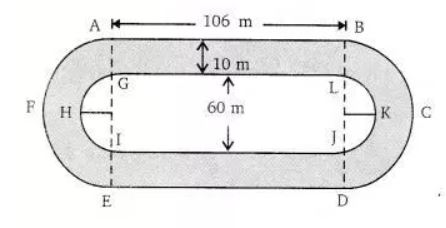
= AB + arc BED + CD + arc DFA
= 106 + 1/2 * 2πr + 106 + 1/2 * 2πr
= 106 + 1/2 * 2 * 22/7 * 30 + 106 + 1/2 * 2 * 22/7 * 30
= 212 + 2 * 22/7 * 30
= 212 + 1320/7
= 2804/7 m2
(ii) area of track = (Area of GHIJ – area of ABCD) + (area of semi-circle HKI – area of semicircle
BEC) + area of semi-circle GLJ – area of semi-circle AFD
= (106 * 80 – 106 * 60) + (1/2) * 22/7 * [402 – 302] + (1/2) * 22/7 * [402 – 302]
= 106(80 – 60) + (1/2) * 22/7 * 700 + (1/2) * 22/7 * 700
= 2120 + 22/7 * 700
= 2120 + 2200
= 4320 m2
Question : 9: In Fig. 12.27, AB and CD are two diameters of a circle (with centre O) perpendicular to each other
and OD is the diameter of the smaller circle. If OA = 7 cm, find the area of the shaded region.

Answer :

Area of smaller circle = πr2 = (22/7) * 7/2 * 7/2 = 77/2 cm2
Radius of larger circle = 7 cm
Area of smaller circle AECFB = (1/2) * πr2 = (1/2) * (22/7) * 7 * 7 = 77 cm2
Area of triangle ACB = (1/2) * AB * OC = (1/2) * 14 * 7 = 49 cm2
Area of shaded region = Area of smaller circle + Area of larger circle – Area of ΔACB
= 77/2 + 77 – 49
= 38.5 + 28
= 66.5 cm2
Question : 10:The area of an equilateral triangle ABC is 17320.5 cm2. With each vertex of the triangle as centre, a
circle is drawn with radius equal to half the length of the side of the triangle (see Fig. 12.28). Find the
area of the shaded region. (Use π = 3.14 and √3 = 1.73205)

Answer :
Let each side of equilateral triangle be a cm

⇒ (√3/4) * a2 = 17320.5
⇒ a2 = 17320.5/(√3/4)
⇒ a2 = (17320.5 * 4)/√3
⇒ a2 = (17320.5 * 4)/1.73205
⇒ a2 = 10000 * 4
⇒ a2 = 40000
⇒ a = 200 cm
Area of sector ADEF = (θ/360°) * πr2
= (60°/360°) * 3.14 * 100 * 100
= (1/6) * 314 * 100
= (1/3) * 157 * 100
= 15700/3 cm2
Now, area of shaded region = Area of equilateral triangle ABC – Area of three sector
= 17320.5 – 3 * 15700/3 = 17320.5 – 15700 = 1620.5 cm2
Question : 11:On a square handkerchief, nine circular designs each of radius 7 cm are made (see Fig. 12.29).
Find the area of the remaining portion of the handkerchief.

Answer :

Area of one circular design = πr2 = (22/7) * 7 * 7 = 22 * 7 = 154 cm2
Side of square = 42 cm
Area of square = (side)2 = 422 = 1764 cm2
Now, area of the remaining portion = area of square – area of 9 circular designs
= 1764 – 9 * 154
= 1764 – 1386
= 378 cm2
Question : 12:In Fig. 12.30, OACB is a quadrant of a circle with centre O
and radius 3.5 cm. If OD = 2 cm, find the area of the
(i) quadrant OACB, (ii) shaded region.
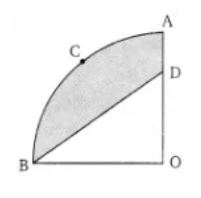
Answer :
(i) Radius of quadrant = 1 cm
Area of quadrant = (θ/360°) * πr2
= (90°/360°) * 22/7 * 3.5 * 3.5
= (1/4) * 22 * 0.5 * 3.5
= (1/4) * 11 * 3.5
= 38.5/4
= 385/40
= 77/8 cm2
Area of ΔOBD = (1/2) * OB * OD = (1/2) * 3.5 * 2 = 3.5 = 35/10 = 7/2 cm2
(ii) Area of shaded region = Area of quadrant – Area of ΔOBD
= 77/8 – 7/2
= (77 – 7 * 4)/8
= (77 – 28)/8
= 49/8 cm2
Question : 13:In Fig. 12.31, a square OABC is inscribed in a quadrant OPBQ.
If OA = 20 cm, find the area of the shaded region. (Use π = 3.14)
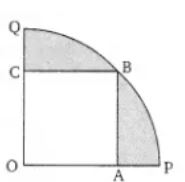
Answer :
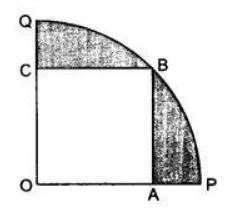
OB2 = OA2 + AB2
⇒ OB2 = 202 + 202
⇒ OB2 = 400 + 400
⇒ OB2 = 800
⇒ OB = √800
⇒ OB = 20√2
Radius of quadrant = 20√2 cm
Area of quadrant = (θ/360°) * πr2
= (90°/360°) * 3.14 * 20√2 * 20√2
= (1/4) * 3.14 * 20√2 * 20√2
= 3.14 * 20√2 * 5√2
= 628 cm2
Area of square = (side)2 = 202 = 400 cm2
Area of shaded region = Area of quadrant – Area of square
= 628 – 400
= 228 cm2
Question : 14:AB and CD are respectively arcs of two concentric circles of radii 21 cm and 7 cm and centre O (see Fig. 12.32).
If ∠ AOB = 30°, find the area of the shaded region.
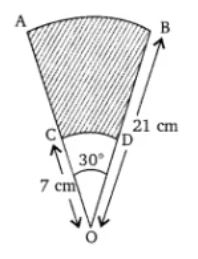
Answer :

= (30°/360°) * π * (21)2 – (30°/360°) * π * 72
= (1/12) * π * 441 – (1/12) * π * 49
= (1/12) * π * (441 – 49)
= (1/12) * 22/7 * 392
= 308/3 cm2
Question : 15:In Fig. 12.33, ABC is a quadrant of a circle of radius 14 cm and a semicircle is drawn with BC
as diameter. Find the area of the shaded region.
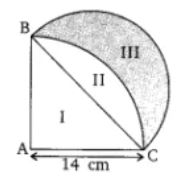
Answer :

Area of sector = (θ/360°) * πr2
= (90°/360°) * 22/7 * 14 * 14
= (1/4) * 22 * 2 * 14
= 11 * 14
= 154 cm2
In ΔABC,
BC2 = AC2 + AB2
⇒ BC2 = 142 + 142
⇒ BC2 = 196 + 196
⇒ BC2 = 392
⇒ BC = √392
⇒ BC = 14√2
Therefore, the diameter of semi-circle = 14√2 cm
Radius of semi-circle = 14√2/2 = 7√2 cm
Area of semi-circle = (1/2) * πr2 = (1/2) * (22/7) * 7√2 * 7√2 = 11 * √2 * 7√2 = 154 cm2
Area of ΔABC = (1/2) * AC * AB = (1/2) * 14 * 14 = 7 * 14 = 98 cm2
Area of shaded region = Area of ΔABC + Area of semi-circle – Area of quadrant
= 98 + 154 – 154
= 98 cm2
Question : 16: Calculate the area of the designed region in Fig. 12.34 common between the two quadrants
of circles of radius 8 cm each.
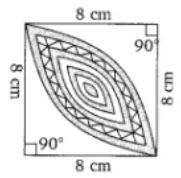
Answer :
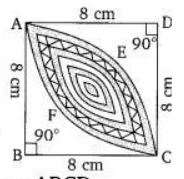
= (90°/360°) * 22/7 * 8 * 8
= (1/4) * 22/7 * 8 * 8
= 352/7 cm2
Area of ΔADC = (1/2) * DC * AD = (1/2) * 8 * 8 = 8 * 4 = 32 cm2
Area of segment = Area of sector DAFC – Area of ΔADC
= 352/7 – 32
= (352 – 32 * 7)/7
= (352 – 224)/7
= 128/7 cm2
Area of shaded region = Area of two segment
= 2 * 128/7
= 256/7 cm2

